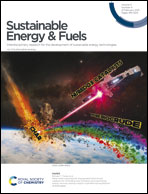A facile method of selective dissolution for preparation of Co3O4/LaCoO3 as a bifunctional catalyst for Al/Zn–air batteries†
Abstract
Perovskites are promising catalysts for metal–air batteries because of their excellent intrinsic catalytic activities. However, low specific surface area and fewer surface defects lead to low catalytic activities in the oxygen reduction/evolution reaction (ORR/OER). Herein, the Co3O4/LaCoO3 composite material is prepared by a selective dissolution method. The onset and half-wave potentials of the Co3O4/LaCoO3 hybrid material are 0.895 and 0.640 V during the ORR process. It also exhibits a small overpotential of 503 mV at a current density of 10 mA cm−2 for the OER process. What's more, the Zn–air battery that uses the Co3O4/LaCoO3 hybrid material can reach a maximum power density of 155.7 mW cm−2, which is larger than that of the original LaCoO3 (137.8 mW cm−2). In addition, the potential difference of this battery with the Co3O4/LaCoO3 sample increased by 22 mV after 100 charge–discharge cycles, which is much lower than that of Zn–air batteries with the LaCoO3 and Co3O4 samples (52 and 26 mV). The above results illustrate that improved bifunctional catalytic properties of the Co3O4/LaCoO3 hybrid material can be associated with the porous structure, large surface area, weak Co–O bond in the lattice and more surface defects on the surface.



 Please wait while we load your content...
Please wait while we load your content...